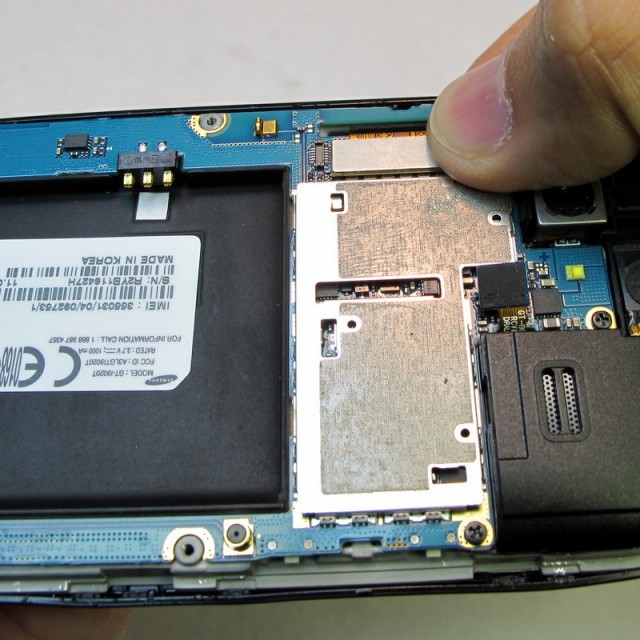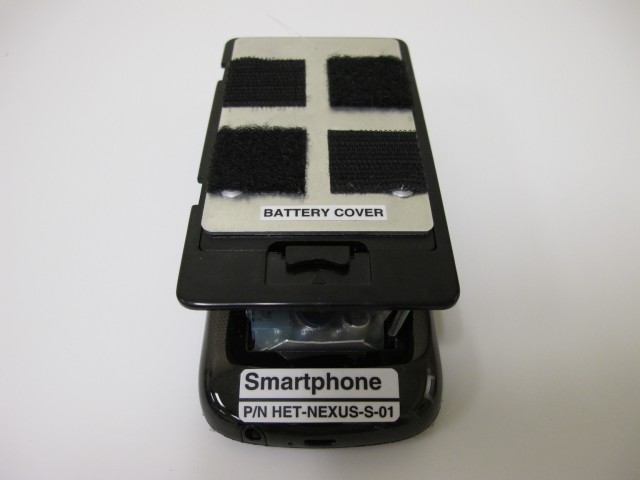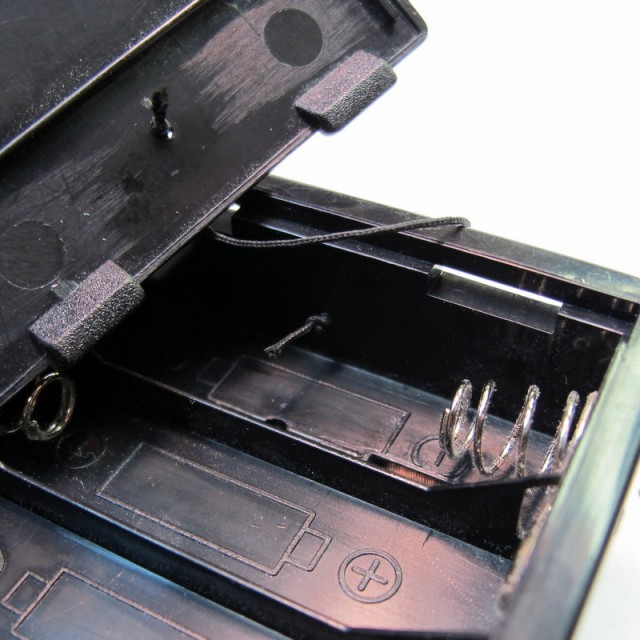Rewiring hardware and software in the Nexus S to make it work on the ISS.

It’s what science fiction dreams are made of: brightly colored, sphere-shaped robots that float above the ground, controlled by a tiny computer brain. But it isn't fiction: it’s the SPHERES satellite, and its brain is an Android smartphone.
Two and a half years ago, the Human Exploration and Telerobotics Project (HET) equipped a trio of these floating robots with Nexus S handsets running Android Gingerbread. (SmartSPHERES, which stands for “Synchronized Position Hold, Engage, Reorient, Experimental Satellites” is a project at NASA's Ames Research Center that's funded by HET). Despite their name, these SPHERES aren't traditional satellites—they're currently being used inside the International Space Station (ISS) to investigate applications like telerobotic cameras and high-latency control, and to measure sound and radiation levels.
More generally, the Android phones will help HET test out news ways of sensing and modeling the ISS so that robots can eventually become an integral part of the space station's operations. Space exploration is still largely a human-controlled operation, but by equipping each of these self-contained satellites with their own Nexus S, the team has enabled them to navigate autonomously while researchers provide high-level commands from Earth. There are currently two Nexus S smartphones at work in the ISS right now.
Hardware upgrades for SPHERES aren't possible without flying completely new equipment up to the ISS, but adopting Android allowed some quick software fixes that would have otherwise been impossible. It took some time and quite a bit of tinkering before the handset was ready to go up in space, however, including some hardware hacking and careful measurements of the accelerometer's accuracy in space.
Why the Nexus S?

The Nexus S as attached to a SPHERES satellite at NASA Ames.
The SPHERES have been in flight since 2006. They were designed for use on the ISS as an upgradable test bed for formation flight and movement in space, where they use compressed CO2thrusters. The project had mainly served to try out experimental software, but the needs of the HET SmartSPHERES project soon exceeded the capabilities of the decade-old processor contained inside the satellites. "By connecting a smartphone, we can immediately make SPHERES more intelligent. With the smartphone, the SPHERES will have a built-in camera to take pictures and video, sensors to help conduct inspections, a powerful computing unit to make calculations, and a Wi-Fi connection that we will use to transfer data in real-time to the space station and mission control,” wrote DW Wheeler, lead engineer in the Intelligent Robots Group at NASA Ames.
"We knew of other projects that were using the Nexus One, and HTC had done some interesting things in that phone that didn't make it ideal for us,” Mark Micire, research scientist and project lead of the Intelligent Robotics Group, told Ars. “It has to do with [HTC's] battery technology—it has to be a proprietary battery or it won’t boot up.”
Micire and the team also figured out that the Nexus S would be much easier to disassemble. “You basically pop it open,” said Micire. “It’s literally six screws on the outside and it comes apart.” Samsung had also separated the circuit boards inside the Nexus S, which made it easier to navigate around the various components featured inside the phone. “We look [at the SPHERES] as a robot that needed a brain, and that’s where Android phones came in.”
Cellphone lobotomies

Enlarge / Cellphone lobotomies can be tricky things, but in NASA's case it worked.
One of the biggest challenges of getting a manufacturer’s proprietary hardware to work with your own is not knowing exactly what’s inside. “When you go with something that already exists, there's a lot of reverse engineering that has to happen,” explained Micire. “Especially in the case of phones: as much as I love our phone manufacturers, they're not always forthcoming about what's actually under the hood.”
In this particular case, the Nexus S had to be forced into permanent airplane mode before it could go up into space, but that couldn't involve a software solution. "When you get on an airplane and they tell you that you have to put it into airplane mode because it'll cause interference with the avionics and stuff—same things on ISS, except they require it to be a hardware switch," said Micire. At the time, before the phone had even premiered, iFixit posted its teardown of the Nexus S. Micire and his team were able to essentially use the high-resolution photos on the site to figure out which chip they had to disengage to disable the cellphone capabilities of the phone. They then waited in line on launch day to secure two phones so that they could perform their own “cellphone lobotomies” to physically remove the offending component. “We almost destroyed the first phone, but by the second phone we figured out which chip to pull,” recalled Micire. “It [was the] TXRX amplifier.”
From there, all the team had to do was test the phone to prove to the flight safety crew that it wouldn't de-orbit the station. It passed. “The phone is none the wiser,” said Micire. “It just thinks it doesn't have cell phone service.”
Space only takes AA batteries

Enlarge / The battery pack strapped on to the Nexus S.
Micire and his team also had to figure out how to power up the phone without using a lithium-ion battery pack. “We were told very early on that getting a lithium-ion battery certified for the station was going to probably be greater than two years,” he explained. But the team had only two years to get this project off the ground.
The only type of batteries that have been cleared for space travel are alkaline, because they degrade “more nicely,” as Micire put it. Rather than explode and catch on fire, alkaline batteries will instead leak electrolyte fluid, which is easier to contain. The team on the Intelligent Robotics Group developed a battery pack for the Nexus S that would replace the lithium ion one with six AA batteries. The pack is then wrapped in a felt-like material that is specifically made to absorb any leakage that might occur, and a few Velcro patches are attached to it so that it can stay fixed to the SPHERES.

Enlarge / A closer look at the AA battery pack strapped on to the Nexus S.
The cellular chip and battery pack weren't the only necessary hardware hacks. If the Nexus One’s glass touchscreen were to shatter in space, the lack of gravity would leave all those broken shards of glass up in the air. It's not bare feet in microgravity the Intelligent Robotics team is trying to protect: it's lungs. Micire explained that the scenario would be too hazardous to imagine. “Those tiny little shards are just floating within the ISS and now you have astronauts that are just breathing them in."
The team figured out that they could use a type of Teflon tape to cover up the chassis of the Nexus S to simultaneously protect the phone and contain any broken pieces from floating about. “You kind of have to take the world that we live in and rework all of the engineering requirements,” Micire reflected. “I never would have thought of broken glass as an inhalant.”
Dealing with drivers—and sensors

The Nexus S runs an app that records activity on the gyroscope, accelerometer, and 3D compass.
As with all types of devices, drivers can be the most finicky part of getting a project up and running. There were a multitude of benefits for the team if it stuck with Android’s Nexus line of phones, the most obvious being that there weren't any setbacks that might come with dealing with customizations performed by OEM manufacturers. “With the Nexus line of phones, you get the full Android open source release source code base—you don’t get that with a lot of the other Android platforms out there,” said Micire. He explained that if it hadn't been for the “pure” Android experience, the team wouldn't have been able to get around some of the driver issues that plague other Android handsets.
One of the issues was getting the phone to sync up with the computers in service on the ISS. The ISS currently uses ThinkPad T61p laptops loaded with Windows XP Service Park 3, and when the Nexus S was plugged into the notebooks, Windows asked for a driver disk—a bit of a problem for a robot that's supposed to remain autonomous. Micire and his team wrote an application that puts the phone into mass-storage mode without a USB cable needing to be plugged into it first. “We figured out the mass storage identified on these phones don’t require a drive—it just works,” said Micire. “Any other phone where we wouldn't have been able to do our own firmware build [would have left us] stuck with the default configuration.”
Before the Nexus S was ready to work, the performance of components like the gyroscope, accelerometer, and 3D compass also needed testing to confirm that they worked in microgravity. The team used a data logger application (which is actually available in the Google Play store) to record the data on the sensors and gather measurements. “[By recording] we were able to show that the sensors did behave as we expected; the accelerometer, it turns out, is not a sensor we can use very well on the SPHERES. But the rest of the sensors actually work really well.”
What's next?
Since the project began in late 2010, it's moved rather quickly despite some of the aforementioned software and hardware hassles. “We went from concept on the back of a napkin to full flight, to delivering our flight units in about six months,” said Micire. “Normally for any major piece of hardware that's going up on station, you're usually talking about a year to two-year process." The team was able to quickly get the project engineered and "fabbed up," as Micire put it, because they leveraged a lot of the stuff that was already built into the phones.
The Nexus S handsets made upgrading the “brain” of the SPHERES a less tedious process, not to mention a more affordable one. But despite NASA Ames’ close proximity to Google's headquarters—Moffett Field is only three miles away—the team at the Intelligent Robotics Group has to purchase their own handsets (though sometimes they do receive help from their friends at Google). “The catalyst for us being able to successfully downgrade and use Android as we have is because Google is just over the fence from us here,” said Micire. “We created very early on this wonderful partnership with folks both inside and outside.”
The Intelligent Robotics Group is currently looking at building the next generation of the Smart SPHERES with a couple of Nexus 4 handsets they have managed to secure. Micire mentioned that the Human Exploration Telerobotics project has also fostered a few relationships with different handset manufacturers for future development, though he was not at liberty to say who.
In the end, the project was possible due to Android’s usefulness beyond mobile phones. "We made the right decision by going with Android because the ability to remove the lithium battery and have it run off of alkaline batteries I think would have been a lot more difficult with the Apple products... and having it work without a driver under Windows XP," said Micire. Earlier he had mentioned how impressed he was by how Android was being embraced by the embedded developer community: "you just get so much that comes for free with the platform.” Micire later added: “It’s humbling to say that even NASA can’t outrun the advancements that are happening with the mobile phone.”
http://arstechnica.com
No comments:
Post a Comment